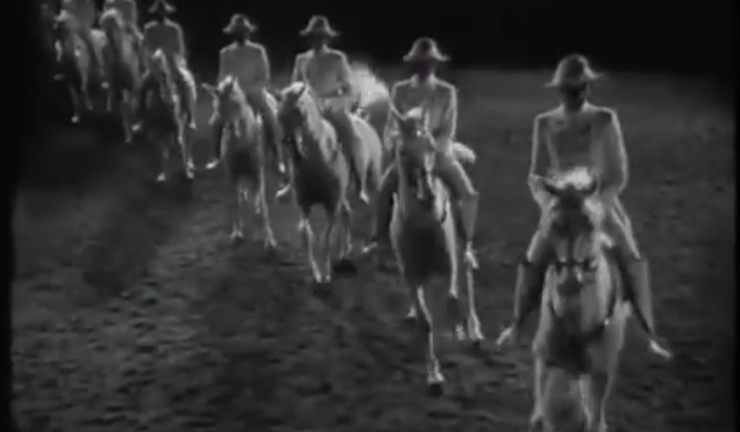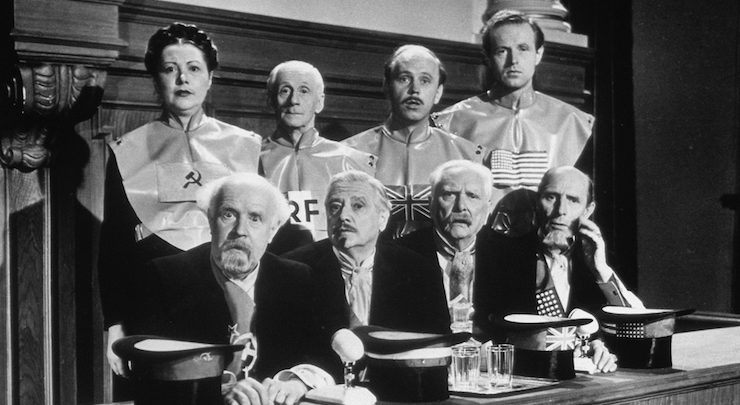Last week in my other twice-monthly column I reread Andre Norton’s postapocalyptic novel, Daybreak—2250 A.D., published in 1952 under the title Star Man’s Son. Among the various and—for the period—diverse cultures in the book are tribes of white people appropriating the horse culture of the Plains Indians. The protagonist at one point manages to capture, tame, and ride one of the tribes’ mares.
Around the time my reread post went live, one of my horse-world colleagues on facebook posted a historical video featuring Lipizzan horses. It so happens that the video dated from 1952, and was an excerpt from a science-fiction film, 1 April 2000. Synchronicity!
1952, it’s clear, was a vintage year for speculation about the future. Norton goes full-on dystopian, transforming the American Midwest into an atomic wasteland full of remnants, refugees, and mutants both benign and unremittingly evil. The film on the other hand presents Austria in the year 2000 as a peaceful country still occupied by the victors (actually they left in 1955, but by 1952 it must have felt as if the occupation would never end), and now making a move to declare independence. The world is fresh and clean, robots perform basic tasks, people fly around in spaceships, and the women’s fashions are amazingly Mod and Sixties.
It’s interesting that a filmmaker from a country that lost the war sees a peaceful if politically constrained future, heavily sanitized and with no mention of the atrocities that were committed by its most infamous native son, Adolf Hitler, while a novelist from one of the victors expects it all to be blasted to slag before the century is out. Of course Austria doesn’t want to continue to be punished for its role in the war, and wants to argue that its culture is good and kind and peaceful, but the United States is well advised to ponder the nature and use of power and the existential danger of the weapon it used to end the war.
But that’s an essay for another time. Here at SFF Equines, we note that both works are not about horses as such, but horses are essential to the plot. In the novel, the protagonist needs emergency transport, and a horse is the best option for the time and place. In the film, one of the strongest arguments the Austrians can muster is the living art of the Spanish Riding School in Vienna.

The film is rather indirect about it. The horses are portrayed in a film within a film, as porcelain figurines come to life. The riders wear white uniforms instead of their usual brown, and their faces are obscured. They’re shown partially in slo-mo to enhance the magic—though some of the school movements are living slo-mo: the horses literally seem to hang in space.
One of the foreign emissaries is a woman, and once she’s seen the horses, that’s it, she’s done. She’s all set to vote in favor of de-occupying Austria. Oh, it’s sexist of course, and rather patronizing, but still. That’s a horsegirl. We really do go all to pieces when we see the white stallions dance. It’s partly mythos and partly that they’re supernaturally beautiful, doing things most horses can and will do on their own, but which are incredibly difficult to elicit on command. It’s actual, live, real-world magic—no visual effects needed.
In keeping with the totally different tone of the Norton novel, protagonist Fors’ experience with the Plains mare is gritty, messy, and complicated. Fors is not a rider and knows little about horses. He’s a mountaineer with a giant Siamese cat, who finds himself in the lowlands with a leg injury and needs an alternative form of transport.
He contemplates stealing a horse from the tribes, but the logistics are impossible. But then, a coincidence! He comes across a herd of wild horses. That’s it! he thinks. He can tame one of these!
I stopped right there for a thorough and invigorating eyeroll with therapeutic primal scream.
I will be fair. Norton admits that this is probably not going to be easy. She ups the coincidence factor by having Fors discover that one of the mares is an escaped Plains mount, therefore is accustomed to humans and has had training.
That’s smart, because training a truly feral horse requires experience, patience, and far more time than Fors can possibly spare. Just capturing it is a major undertaking, and then it has to be domesticated.
The mare is a good choice for another reason. Because she’s a mare of a certain age, she’s used to things climbing on her back: the stallion for breeding, and foals because they can be brats, especially if they’re boys. A human on her back is not a threat to her very life, as it would be if she were a stallion. And with age and babies comes a certain level of emotional calm and ability to cope with stress. She’s about as good an option as Fors is going to find.
So far so good, as far as it goes. Fors captures the mare, refreshes her memory of human handling, and proceeds to teach himself to ride. In the process this complete non-horseman with bonus damaged leg figures out how to rig a bridle, manages to get on the mare’s back, and just about immediately rides off, bareback, with minimal difficulty.
Here’s where the horse person puts the book down and says, Uh. No. Writer is not a rider.
Riding looks easy. You just sit there, right?
Right.
Fors is young and athletic, which helps. But the muscles he uses to walk and run are not the muscles he needs for riding. He’s also facing the need to balance his human conformation on top of a moving object with a mind of its own. He has to stay in the middle, balance in three dimensions—because horses move sideways as well as forward and back—and also, while he’s doing that, figure out how to make the horse stop, go, and steer.
This requires considerable coordination and a lot of core strength, as well as a completely different kind of balance than the walker or runner will need. Riding a boat or a raft is preparation of a sort, so Fors has that. But he’s riding with an injury. Without training. Without conditioning of the specific muscle groups.
Even a short ride can leave a beginner hobbling. Male beginners are further challenged by stiffer muscles and ligaments in general, and then there’s the extra equipment in the region that’s in contact with the horse.
It’s nowhere near as simple as getting in a car and driving where he needs to go. A motorcycle would be a closer analogy, but the machine isn’t moving in multiple directions at once, and the seat is designed to accommodate the rider’s anatomy. There won’t be the kind of friction a horseback rider encounters. Riding in a saddle is a challenge in itself. Riding bareback is a whole other level of ow.
Let’s suppose the mare has a comfortable back—she’s got some upholstery, so her spine won’t be threatening to cut Fors in half starting with his most tender bits. Comfort has a price. It’s wide, so the hip flexors get stretched, which over time can be quite painful. And that’s presuming the rider is well enough balanced that he doesn’t roll right off as soon as the horse moves faster than a slow walk.
Don’t forget the bad leg, either. Sitting on the horse as she moves will be excruciating. This will stiffen him up as he guards against the pain. The stiffer he gets, the less balanced he’s likely to be, and the more likely it is that he’ll fall off. Any sudden move, stumble, unexpected stop or go, and he’s gone.
Falling off without breaking oneself or losing the horse takes skill. Riders learn how to fall and how to keep the reins—not always guaranteed; sometimes there’s no way to survive the fall but let go, relax as much as possible, and let it happen. A novice rider with an injury is probably not going to last a day without exacerbating the injury and losing his horse.
The choice of a previously trained mare is sensible. But how Fors manages once he’s on her is pretty much a fantasy. Without the bad leg that requires him to find transport in the first place, he’d still run into problems: even supposing he stays on, the strained muscles and the chafing would make the experience a misery. With the leg, he’s adding not only whole new levels of pain but the high likelihood of making the wound much worse. All that jostling and shifting, plus the falling off, plus the having to get on and off voluntarily in between falls—ow. That’s all I have to say. Ow.
When we say a horse is not a motorcycle, we do mean it. Same goes for riding being a lot harder than it looks. One does toughen up with time and practice, but those first few days will not be anything like as easy as Norton makes them seem. I winced as I read, thinking about what would really be happening to that poor, beat-up, leg-wounded kid and his poor, patient horse.
We won’t even talk about what eventually happened to the horse. I understand narrative necessity, but still. In my universe, if the cat gets to live, the horse does, too. Because I’m a horsegirl, and that’s how my priorities roll.
Special thanks to Chloe Larson for the Lipizzaner video—the latest of many that she has tracked down and shared with her fellow enthusiasts.
Judith Tarr is a lifelong horse person. She supports her habit by writing works of fantasy and science fiction as well as historical novels, many of which have been published as ebooks by Book View Cafe. She’s even written a primer for writers who want to write about horses: Writing Horses: The Fine Art of Getting It Right. Her most recent short novel, Dragons in the Earth, features a herd of magical horses, and her space opera, Forgotten Suns, features both terrestrial horses and an alien horselike species (and space whales!). She lives near Tucson, Arizona with a herd of Lipizzans, a clowder of cats, and a blue-eyed dog.










